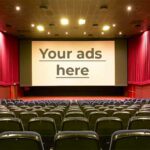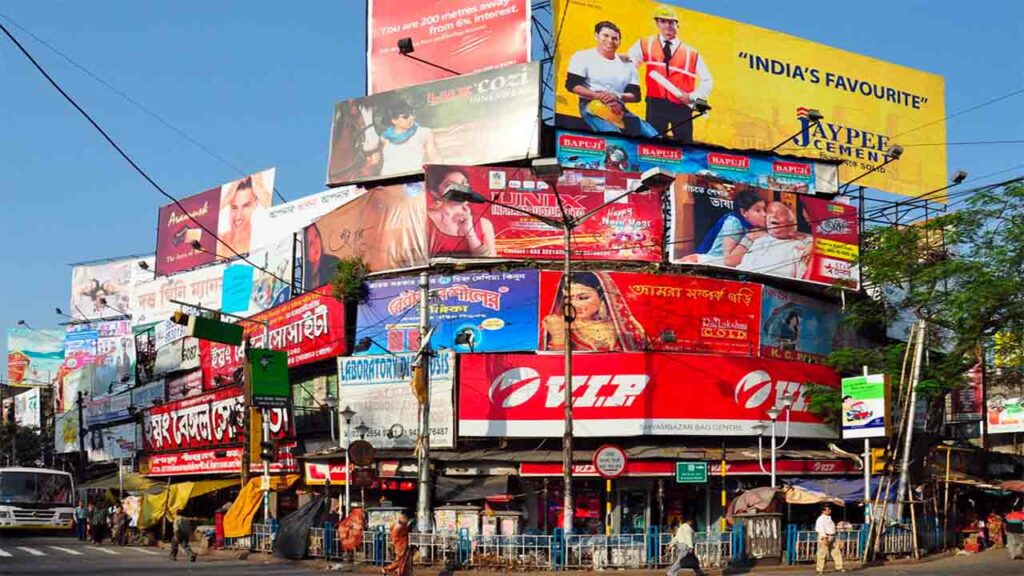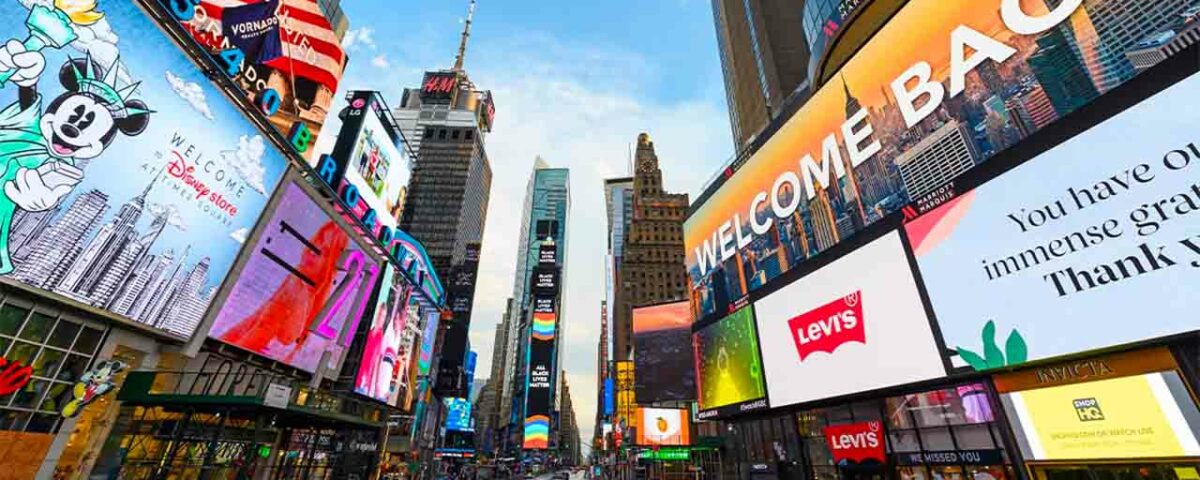


Guerilla Marketing: The Best Strategy for Any Business
November 2, 2023


Cinema Advertising in India – Top 10 Cinema Halls to Advertise
November 9, 2023Billboard advertising has been a prominent marketing tool for businesses across the globe. In India, this form of outdoor advertising has gained significant traction due to its ability to capture the attention of a diverse and vast audience.
As businesses strive to make their mark in the competitive market, understanding the cost and strategies behind billboard advertising in India becomes crucial. In this article, we delve into the various aspects of billboard advertising costs, effective strategies, and its impact on the Indian market.
Billboards have managed to stay relevant in the age of digital marketing due to their larger-than-life presence and potential to reach a wide audience. The rapid digitalization has indeed impacted traditional advertising methods, but billboards have evolved to complement the digital landscape.
Billboard advertising costs in India exhibit a diverse spectrum based on factors such as city, size, and location. Understanding this variability is crucial for effective budget allocation.
This assortment of starting costs across cities showcases the significant impact of city dynamics, including market demand and prominence, on billboard advertising expenses. With differences in sizes and pricing models (per square foot in Ahmedabad), businesses must consider the unique cost landscape of each city when planning their billboard advertising campaigns.
Factors Influencing Billboard Advertising Costs
The cost of billboard advertising in India can vary significantly based on several factors. The location of the billboard plays a pivotal role, with prime spots in metropolitan cities commanding higher fees. The size and complexity of the design, along with the duration of the display, also contribute to the overall cost.
- Location
The prime location of the billboard, such as busy intersections, popular tourist spots, and urban centers, significantly affects the cost. High-traffic areas command higher fees due to increased visibility.
- Size and Design Complexity:
Larger billboards and intricate designs require more materials, labor, and maintenance, leading to higher costs. The complexity of the design can also impact production expenses.
- Duration of Display:
The length of time the advertisement will be displayed on the billboard plays a role. Longer display periods may lead to negotiated discounts, while shorter campaigns might have higher costs per day.
- Traffic and Audience Demographics:
Billboards in areas with a larger and more diverse audience tend to have higher costs. The demographics of the passing traffic, such as income levels and interests, can also influence pricing.
- Demand and Availability:
Limited availability of prime billboard spaces can increase demand, leading to higher costs. Conversely, areas with more available billboard slots may have more competitive pricing.
Comparing Different Types of Billboards
Static billboards, digital billboards, and transit advertising offer distinct advantages.
Static Billboards:


- Timeless Presence: Static billboards offer a consistent and unchanging presence. Once installed, their message remains the same, providing a reliable and continuous display that can become iconic in the local landscape.
- Visual Impact: With a fixed design, static billboards can focus on creating a visually striking and memorable image. This design stability ensures that passersby can easily recognize the brand or message over time.
- Cost-Effectiveness: Static billboards often have a lower initial cost compared to digital alternatives. This makes them a practical choice for businesses with limited advertising budgets.
- Minimal Maintenance: Since the content remains unchanged, static billboards require minimal maintenance, reducing the need for frequent updates and associated costs.
Digital Billboards:


- Dynamic Content: Digital billboards allow for dynamic content changes. Advertisers can alter their messages, images, and even videos in real-time, enabling timely promotions and adaptability to various events.
- Enhanced Engagement: The ability to display moving visuals and animations can capture attention more effectively than static billboards. This heightened engagement can lead to better brand recall and message retention.
- Dayparting: Digital billboards enable advertisers to display different content based on the time of day. This feature ensures that the message is relevant to the audience during different hours, optimizing its impact.
- Multiple Ads in One Space: Digital billboards can cycle through multiple advertisements within a short span, effectively utilizing the same advertising space for various messages.
Understanding the Cost Structure
When it comes to billboard advertising, understanding the cost structure is crucial for businesses aiming to maximize their marketing investment. The expenses associated with billboard campaigns encompass various components that contribute to the overall effectiveness and reach of the advertisement. Let’s delve into the details of this cost structure:
1. One-Time Setup Fees:
- Design and Artwork: The initial phase involves creating an eye-catching and impactful design that resonates with the target audience. Design costs encompass graphic design work, layout creation, and ensuring the content aligns with the brand’s identity and message.
- Installation: Setting up the physical billboard requires labor, equipment, and materials. From constructing the frame to installing the advertising panel, these installation costs are incurred only once but play a vital role in the overall cost structure.
2. Rental Charges:
- Location Significance: The geographic location of the billboard plays a pivotal role in determining rental charges. Prime locations in high-traffic areas or areas with high visibility command a premium due to the increased exposure they offer.
- Billboard Size: The size of the billboard directly impacts the rental cost. Larger billboards offer more space for creative content and tend to have higher rental fees. Smaller billboards might be more budget-friendly but offer less prominent visibility.
- Type of Billboard: Different types of billboards, such as traditional static billboards, digital billboards, or transit advertising, come with varying rental rates. Digital billboards, with their dynamic capabilities, often come at a higher cost due to their technological features.
3. Maintenance Costs:
- Ensuring Visual Impact: Maintenance expenses are crucial to maintaining the visual impact of the billboard throughout its display period. This includes routine cleaning to remove dust, dirt, and other environmental factors that can obscure the advertisement.
- Technical Upkeep (Digital Billboards): Digital billboards require ongoing technical support to ensure smooth functioning of dynamic content and timely updates. These costs cover issues related to software, hardware, and connectivity.
4. Lighting and Electricity:
- Illumination: Billboards with lighting elements require electricity to illuminate the content during nighttime hours. The electricity cost adds to the overall operational expenses of the billboard.
- Energy-Efficiency Considerations: Advertisers are increasingly opting for energy-efficient lighting options to reduce ongoing operational costs and minimize the environmental impact.
5. Permitting and Regulatory Fees:
- Legal Compliance: Obtaining permits and adhering to regulatory requirements set by local authorities is essential for billboard advertising. These fees are essential to ensure legal operation and avoid penalties.
Measuring ROI on Billboard Advertising
Assessing the return on investment (ROI) for billboard advertising is essential to gauge the success and effectiveness of your marketing efforts. By accurately measuring the impact of your billboard campaigns, you can make informed decisions for future strategies and optimize your advertising budget.
- Footfall Tracking:
By closely monitoring foot traffic around the billboard location, you can gain valuable insights into the number of potential viewers your advertisement is reaching. Counting passersby provides an initial estimate of the exposure your billboard campaign is generating in a specific area.
- Engagement Levels:
Tracking engagement metrics such as the number of website visits, social media interactions, and other online engagements offers a deeper understanding of how effectively your billboard is encouraging audience interaction. These metrics provide a quantitative measure of how well your campaign is resonating with your target audience.
- Conversions and Lead Generation:
Measuring conversions and lead generation is a crucial aspect of ROI assessment. Tracking responses to call-to-action elements, such as website clicks, phone calls, or emails, helps you determine the effectiveness of your campaign in driving real-world outcomes. These metrics provide tangible evidence of how successful your billboard is at converting viewers into potential customers or leads.
- Digital Tracking Tools:
Incorporating digital tools like QR codes or short links into your billboard design allows viewers to engage directly with your online content. Tracking the clicks on these links provides you with valuable digital insights into the effectiveness of your campaign. Geolocation analytics complement this by helping you identify where these interactions are originating from, enabling you to optimize future placements based on data.
- Comparative Analysis:
A/B testing involves running multiple versions of your billboard with slight variations to identify which designs, messages, or elements are more effective in capturing audience attention and driving engagement. Monitoring social media impact, especially the usage of campaign-related hashtags, provides a qualitative measure of how your campaign is resonating across online platforms.
Conclusion
Billboard advertising, a longstanding tool globally, has found new life in India due to its potential to capture attention within a diverse and expansive audience. In the fiercely competitive market, comprehending the nuances of costs and strategies linked to billboard advertising is essential. This understanding empowers businesses to wield billboard advertising as a formidable weapon in their marketing arsenal.
In summation, understanding the cost dynamics and strategic intricacies of billboard advertising opens a world of possibilities for businesses seeking to captivate their audience. The fusion of innovation, informed decision-making, and creative prowess serves as the cornerstone of a successful billboard advertising campaign in the diverse and dynamic landscape of India.



